Cohen I.M., Kundu P.K. Fluid Mechanics
Подождите немного. Документ загружается.


362 Boundary Layers and Related Topics
6. von Karman Momentum Integral
Exact solutions of the boundary layer equations are possible only in simple cases,
such as that over a flat plate. In more complicated problems a frequently applied
approximate method satisfies only an integral of the boundary layer equations across
the layer thickness. The integral was derived by von Karman in 1921 and applied to
several situations by Pohlhausen.
The point of an integral formulation is to obtain the information that is really
required with minimum effort. The important results of boundary layer calculations
are the wall shear stress, displacement thickness, and separation point. With the help
of the von Karman momentum integral derived in what follows and additional corre-
lations, these results can be obtained easily.
The equation is derived by integrating the boundary layer equation
u
∂u
∂x
+ v
∂u
∂y
= U
dU
dx
+ ν
∂
2
u
∂y
2
,
from y = 0toy = h, where h>δis any distance outside the boundary layer. Here
the pressure gradient term has been expressed in terms of the velocity U(x) at the
edge of the boundary layer, where the inviscid Euler equation applies. Adding and
subtracting u(dU/dx), we obtain
(U − u)
dU
dx
+ u
∂(U − u)
∂x
+ v
∂(U − u)
∂y
=−ν
∂
2
u
∂y
2
. (10.42)
Integrating from y = 0toy = h, the various terms of this equation transform as
follows.
The first term gives
h
0
(U − u)
dU
dx
dy = Uδ
∗
dU
dx
.
Integrating by parts, the third term gives,
h
0
v
∂(U − u)
∂y
dy =
v(U − u)
h
0
−
h
0
∂v
∂y
(U − u) dy
=
h
0
∂u
∂x
(U − u) dy,
where we have used the continuity equation and the conditions that v = 0aty = 0
and u = U at y = h. The last term in equation (10.42) gives
−ν
h
0
∂
2
u
∂y
2
dy =
τ
0
ρ
,

6. von Karman Momentum Integral 363
where τ
0
is the wall shear stress.
The integral of equation (10.42) is therefore
Uδ
∗
dU
dx
+
h
0
u
∂(U − u)
∂x
+ (U − u)
∂u
∂x
dy =
τ
0
ρ
. (10.43)
The integral in equation (10.43) equals
h
0
∂
∂x
[u(U − u)]dy =
d
dx
h
0
u(U − u) dy =
d
dx
(U
2
θ),
where θ is the momentum thickness defined by equation (10.17). Equation (10.43)
then gives
d
dx
(U
2
θ) + δ
∗
U
dU
dx
=
τ
0
ρ
,
(10.44)
which is called the Karman momentum integral equation. In equation (10.44), θ,
δ
∗
, and τ
0
are all unknown. Additional assumptions must be made or correlations
provided to obtain a useful solution. It is valid for both laminar and turbulent boundary
layers. In the latter case τ
0
cannot be equated to molecular viscosity times the velocity
gradient and should be empirically specified. The procedure of applying the integral
approach is to assume a reasonable velocity distribution, satisfying as many conditions
as possible. Equation (10.44) then predicts the boundary layer thickness and other
parameters.
The approximate method is only useful in situations where an exact solution
does not exist. For illustrative purposes, however, we shall apply it to the boundary
layer over a flat plate where U(dU/dx) = 0. Using definition (10.17) for θ , equa-
tion (10.44) reduces to
d
dx
δ
0
(U − u)u dy =
τ
0
ρ
. (10.45)
Assume a cubic profile
u
U
= a + b
y
δ
+ c
y
2
δ
2
+ d
y
3
δ
3
.
The four conditions that we can satisfy with this profile are chosen to be
u = 0,
∂
2
u
∂y
2
= 0aty = 0,
u = U,
∂u
∂y
= 0aty = δ.

364 Boundary Layers and Related Topics
The condition that ∂
2
u/∂y
2
= 0 at the wall is a requirement in a boundary layer
over a flat plate, for which an application of the equation of motion (10.8) gives
ν(∂
2
u/∂y
2
)
0
= U(dU/dx) = 0. Determination of the four constants reduces the
assumed profile to
u
U
=
3
2
y
δ
−
1
2
y
δ
3
.
The terms on the left- and right-hand sides of the momentum equation (10.45)
are then
δ
0
(U − u)u dy =
39
280
U
2
δ,
τ
0
ρ
= ν
∂u
∂y
0
=
3
2
Uν
δ
.
Substitution into the momentum integral equation gives
39U
2
280
dδ
dx
=
3
2
Uν
δ
.
Integrating in x and using the condition δ = 0atx = 0, we obtain
δ = 4.64
νx/U,
which is remarkably close to the exact solution (10.36). The friction factor is
C
f
=
τ
0
(1/2)ρU
2
=
(3/2)U ν/δ
(1/2)U
2
=
0.646
√
Re
x
,
which is also very close to the exact solution of equation (10.38).
Pohlhausen found that a fourth-degree polynomial was necessary to exhibit sen-
sitivity of the velocity profile to the pressure gradient. Adding another term below
equation (10.45), e(y/δ)
4
requires an additional boundary condition, ∂
2
u/∂y
2
= 0
at y = δ. With the assumption of a form for the velocity profile, equation (10.44)
may be reduced to an equation with one unknown, δ(x) with U(x), or the pressure
gradient specified. This equation was solved approximately by Pohlhausen in 1921.
This is described in Yih (1977, pp. 357–360). Subsequent improvements by Holstein
and Bohlen (1940) are recounted in Schlichting (1979, pp. 206–217) and Rosenhead
(1988, pp. 293–297). Sherman (1990, pp. 322–329) related the approximate solution
due to Thwaites.
7. Effect of Pressure Gradient
So far we have considered the boundary layer on a flat plate, for which the pressure
gradient of the external stream is zero. Now suppose that the surface of the body is
curved (Figure 10.13). Upstream of the highest point the streamlines of the outer flow
converge, resulting in an increase of the free stream velocity U(x) and a consequent
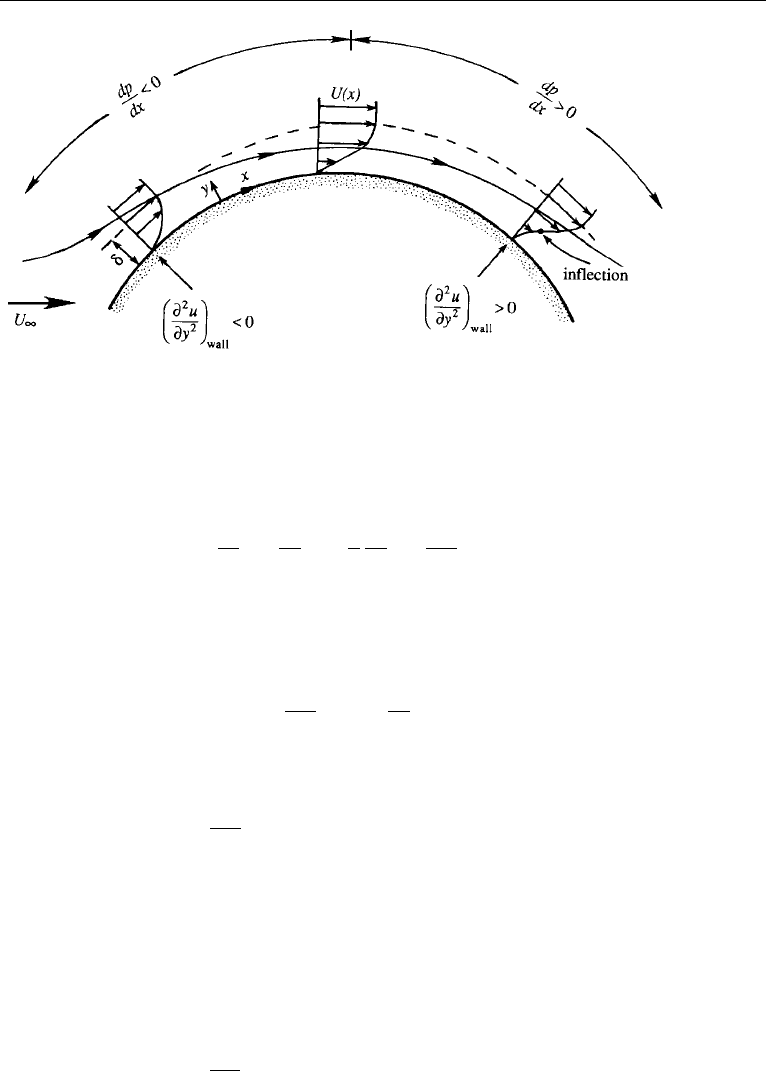
7. Effect of Pressure Gradient 365
Figure 10.13 Velocity profiles across boundary layers with favorable and adverse pressure gradients.
fall of pressure with x. Downstream of the highest point the streamlines diverge,
resulting in a decrease of U(x)and a rise in pressure. In this section we shall investigate
the effect of such a pressure gradient on the shape of the boundary layer profile u(x, y).
The boundary layer equation is
u
∂u
∂x
+ v
∂u
∂y
=−
1
ρ
∂p
∂x
+ ν
∂
2
u
∂y
2
,
where the pressure gradient is found from the external velocity field as dp/dx
=−ρU (dU/dx), with x taken along the surface of the body. At the wall, the boundary
layer equation becomes
µ
∂
2
u
∂y
2
wall
=
∂p
∂x
.
In an accelerating stream dp/dx < 0, and therefore
∂
2
u
∂y
2
wall
< 0 (accelerating). (10.46)
As the velocity profile has to blend in smoothly with the external profile, the slope
∂u/∂y slightly below the edge of the boundary layer decreases with y from a positive
value to zero; therefore, ∂
2
u/∂y
2
slightly below the boundary layer edge is negative.
Equation (10.46) then shows that ∂
2
u/∂y
2
has the same sign at both the wall and the
boundary layer edge, and presumably throughout the boundary layer. In contrast, for
a decelerating external stream, the curvature of the velocity profile at the wall is
∂
2
u
∂y
2
wall
> 0 (decelerating). (10.47)

366 Boundary Layers and Related Topics
so that the curvature changes sign somewhere within the boundary layer. In other
words, the boundary layer profile in a decelerating flow has a point of inflection
where ∂
2
u/∂y
2
= 0. In the limiting case of a flat plate, the point of inflection is at
the wall.
The shape of the velocity profiles in Figure 10.13 suggests that a decelerating
pressure gradient tends to increase the thickness of the boundary layer. This can also
be seen from the continuity equation
v(y) =−
y
0
∂u
∂x
dy.
Compared to a flat plate, a decelerating external stream causes a larger −∂u/∂x within
the boundary layer because the deceleration of the outer flow adds to the viscous
deceleration within the boundary layer. It follows from the foregoing equation that
the v-field, directed away from the surface, is larger for a decelerating flow. The
boundary layer therefore thickens not only by viscous diffusion but also by advection
away from the surface, resulting in a rapid increase in the boundary layer thickness
with x.
If p falls along the direction of flow, dp/dx < 0 and we say that the pressure
gradient is “favorable.” If, on the other hand, the pressure rises along the direction
of flow, dp/dx > 0 and we say that the pressure gradient is “adverse” or “uphill.”
The rapid growth of the boundary layer thickness in a decelerating stream, and the
associated large v-field, causes the important phenomenon of separation, in which
the external stream ceases to flow nearly parallel to the boundary surface. This is
discussed in the next section.
8. Separation
We have seen in the last section that the boundary layer in a decelerating stream
has a point of inflection and grows rapidly. The existence of the point of inflection
implies a slowing down of the region next to the wall, a consequence of the uphill
pressure gradient. Under a strong enough adverse pressure gradient, the flow next
to the wall reverses direction, resulting in a region of backward flow (Figure 10.14).
The reversed flow meets the forward flow at some point S at which the fluid near the
surface is transported out into the mainstream. We say that the flow separates from
the wall. The separation point S is defined as the boundary between the forward flow
and backward flow of the fluid near the wall, where the stress vanishes:
∂u
∂y
wall
= 0 (separation).
It is apparent from the figure that one streamline intersects the wall at a definite angle
at the point of separation.
At lower Reynolds numbers the reversed flow downstream of the point of sep-
aration forms part of a large steady vortex behind the surface (see Figure 10.17 in
Section 9 for the range 4 < Re < 40). At higher Reynolds numbers, when the flow
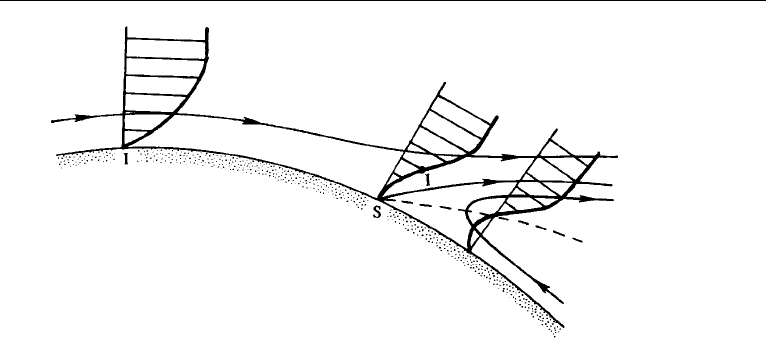
8. Separation 367
Figure 10.14 Streamlines and velocity profiles near a separation point S. Point of inflection is indicated
by I. The dashed line represents u = 0.
has boundary layer characteristics, the flow downstream of separation is unsteady and
frequently chaotic.
How strong an adverse pressure gradient the boundary layer can withstand with-
out undergoing separation depends on the geometry of the flow, and whether the
boundary layer is laminar or turbulent. A steep pressure gradient, such as that behind
a blunt body, invariably leads to a quick separation. In contrast, the boundary layer on
the trailing surface of a thin body can overcome the weak pressure gradients involved.
Therefore, to avoid separation and large drag, the trailing section of a submerged body
should be gradually reduced in size, giving it a so-called streamlined shape.
Evidence indicates that the point of separation is insensitive to the Reynolds
number as long as the boundary layer is laminar. However, a transition to turbulence
delays boundary layer separation; that is, a turbulent boundary layer is more capable
of withstanding an adverse pressure gradient. This is because the velocity profile
in a turbulent boundary layer is “fuller” (Figure 10.15) and has more energy. For
example, the laminar boundary layer over a circular cylinder separates at 82
◦
from
the forward stagnation point, whereas a turbulent layer over the same body separates
at 125
◦
(shown later in Figure 10.17). Experiments show that the pressure remains
fairly uniform downstream of separation and has a lower value than the pressures on
the forward face of the body. The resulting drag due to pressure forces is called form
drag, as it depends crucially on the shape of the body. For a blunt body the form drag
is larger than the skin friction drag because of the occurrence of separation. (For a
streamlined body, skin friction is generally larger than the form drag.) As long as
the separation point is located at the same place on the body, the drag coefficient
of a blunt body is nearly constant at high Reynolds numbers. However, the drag
coefficient drops suddenly when the boundary layer undergoes transition to turbulence
(see Figure 10.22 in Section 9). This is because the separation point then moves
downstream, and the wake becomes narrower.
Separation takes place not only in external flows, but also in internal flows such as
that in a highly divergent channel (Figure 10.16). Upstream of the throat the pressure
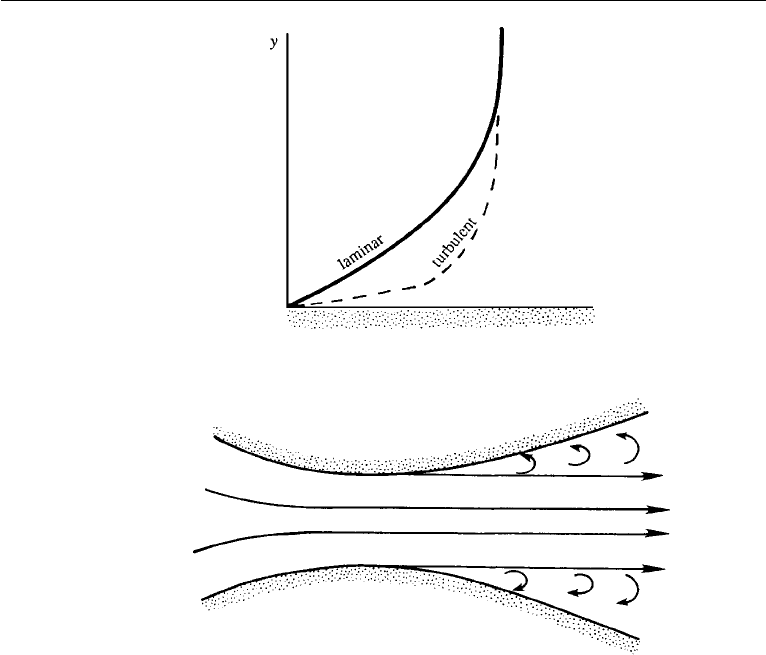
368 Boundary Layers and Related Topics
Figure 10.15 Comparison of laminar and turbulent velocity profiles in a boundary layer.
Figure 10.16 Separation of flow in a highly divergent channel.
gradient is favorable and the flow adheres to the wall. Downstream of the throat a
large enough adverse pressure gradient can cause separation.
The boundary layer equations are valid only as far downstream as the point of
separation. Beyond it the boundary layer becomes so thick that the basic underly-
ing assumptions become invalid. Moreover, the parabolic character of the boundary
layer equations requires that a numerical integration is possible only in the direc-
tion of advection (along which information is propagated), which is upstream within
the reversed flow region. A forward (downstream) integration of the boundary layer
equations therefore breaks down after the separation point. Last, we can no longer
apply potential theory to find the pressure distribution in the separated region, as the
effective boundary of the irrotational flow is no longer the solid surface but some
unknown shape encompassing part of the body plus the separated region.
9. Description of Flow past a Circular Cylinder
In general, analytical solutions of viscous flows can be found (possibly in terms
of perturbation series) only in two limiting cases, namely Re 1 and Re 1.

9. Description of Flow past a Circular Cylinder 369
In the Re 1 limit the inertia forces are negligible over most of the flow field; the
Stokes–Oseen solutions discussed in the preceding chapter are of this type. In the
opposite limit of Re 1, the viscous forces are negligible everywhere except close
to the surface, and a solution may be attempted by matching an irrotational outer
flow with a boundary layer near the surface. In the intermediate range of Reynolds
numbers, finding analytical solutions becomes almost an impossible task, and one has
to depend on experimentation and numerical solutions. Some of these experimental
flow patterns will be described in this section, taking the flow over a circular cylinder
as an example. Instead of discussing only the intermediate Reynolds number range,
we shall describe the experimental data for the entire range of small to very high
Reynolds numbers.
Low Reynolds Numbers
Let us start with a consideration of the creeping flow around a circular cylinder,
characterized by Re < 1. (Here we shall define Re = U
∞
d/ν, based on the upstream
velocity and the cylinder diameter.) Vorticity is generated close to the surface because
of the no-slip boundary condition. In the Stokes approximation this vorticity is simply
diffused, not advected, which results in a fore and aft symmetry. The Oseen approxi-
mation partially takes into account the advection of vorticity, and results in an asym-
metric velocity distribution far from the body (which was shown in Figure 9.17). The
vorticity distribution is qualitatively analogous to the dye distribution caused by a
source of colored fluid at the position of the body. The color diffuses symmetrically
in very slow flows, but at higher flow speeds the dye source is confined behind a
parabolic boundary with the dye source at the focus.
As Re is increased beyond 1, the Oseen approximation breaks down, and the vor-
ticity is increasingly confined behind the cylinder because of advection. For Re > 4,
two small attached or “standing” eddies appear behind the cylinder. The wake is com-
pletely laminar and the vortices act like “fluidynamic rollers” over which the main
stream flows (Figure 10.17). The eddies get longer as Re is increased.
von Karman Vortex Street
A very interesting sequence of events begins to develop when the Reynolds number is
increased beyond 40, at which point the wake behind the cylinder becomes unstable.
Photographs show that the wake develops a slow oscillation in which the velocity
is periodic in time and downstream distance, with the amplitude of the oscillation
increasing downstream. The oscillating wake rolls up into two staggered rows of
vortices with opposite sense of rotation (Figure 10.18). von Karman investigated the
phenomenon as a problem of superposition of irrotational vortices; he concluded that
a nonstaggered row of vortices is unstable, and a staggered row is stable only if the
ratio of lateral distance between the vortices to their longitudinal distance is 0.28.
Because of the similarity of the wake with footprints in a street, the staggered row
of vortices behind a blunt body is called a von Karman vortex street. The vortices
move downstream at a speed smaller than the upstream velocity U
∞
. This means
that the vortex pattern slowly follows the cylinder if it is pulled through a stationary
fluid.
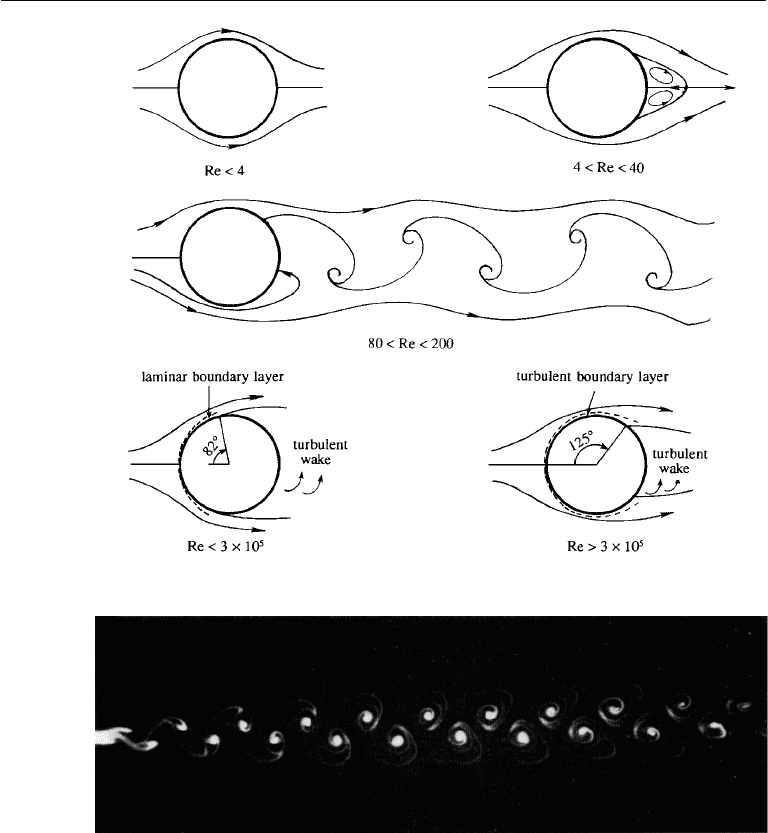
370 Boundary Layers and Related Topics
Figure 10.17 Some regimes of flow over a circular cylinder.
Figure 10.18 von Karman vortex street downstream of a circular cylinder at Re = 55. Flow visualized by
condensed milk. S. Taneda, Jour. Phys. Soc., Japan 20: 1714–1721, 1965, and reprinted with the permission
of The Physical Society of Japan and Dr. Sadatoshi Taneda.
In the range 40 < Re < 80, the vortex street does not interact with the pair
of attached vortices. As Re is increased beyond 80 the vortex street forms closer to
the cylinder, and the attached eddies (whose downstream length has now grown to be
about twice the diameter of the cylinder) themselves begin to oscillate. Finally the
attached eddies periodically break off alternately from the two sides of the cylinder.
While an eddy on one side is shed, that on the other side forms, resulting in an unsteady
flow near the cylinder. As vortices of opposite circulations are shed off alternately
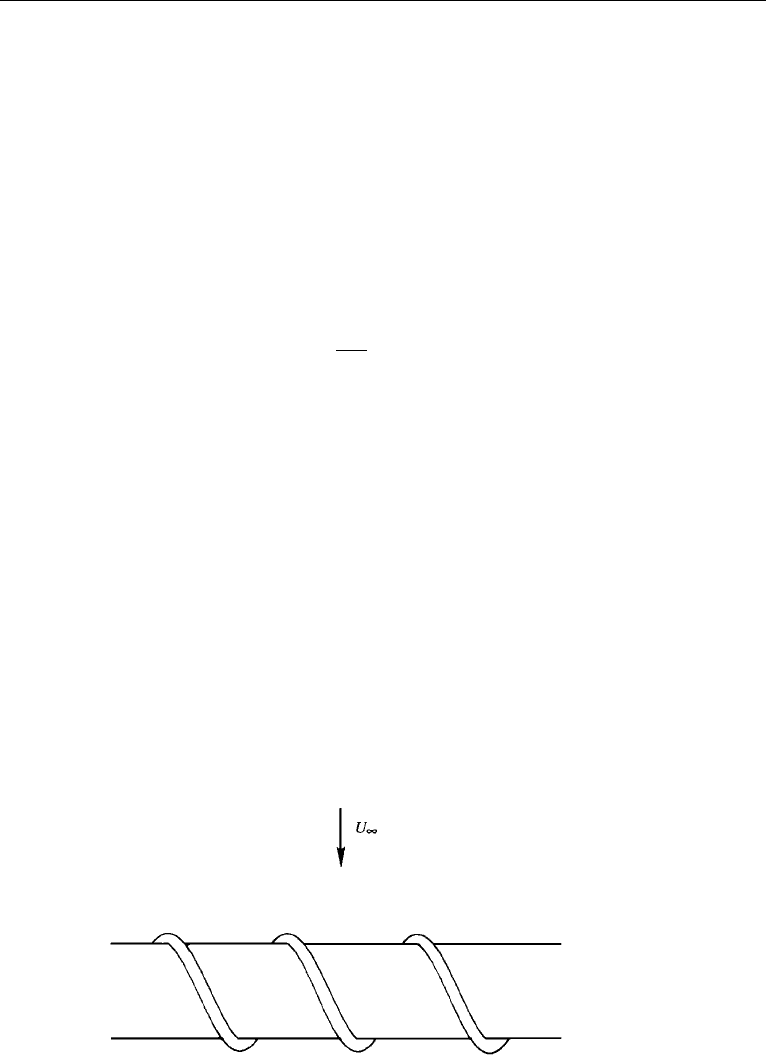
9. Description of Flow past a Circular Cylinder 371
from the two sides, the circulation around the cylinder changes sign, resulting in
an oscillating “lift” or lateral force. If the frequency of vortex shedding is close
to the natural frequency of some mode of vibration of the cylinder body, then an
appreciable lateral vibration has been observed to result. Engineering structures such
as suspension bridges and oil drilling platforms are designed so as to break up a
coherent shedding of vortices from cylindrical structures. This is done by including
spiral blades protruding out of the cylinder surface, which break up the spanwise
coherence of vortex shedding, forcing the vortices to detach at different times along
the length of these structures (Figure 10.19).
The passage of regular vortices causes velocity measurements in the wake to have
a dominant periodicity. The frequency n is expressed as a nondimensional parameter
known as the Strouhal number, defined as
S ≡
nd
U
∞
.
Experiments show that for a circular cylinder the value of S remains close to 0.21 for a
large range of Reynolds numbers. For small values of cylinder diameter and moderate
values of U
∞
, the resulting frequencies of the vortex shedding and oscillating lift lie
in the acoustic range. For example, at U
∞
= 10 m/s and a wire diameter of 2 mm,
the frequency corresponding to a Strouhal number of 0.21 is n = 1050 cycles per
second. The “singing” of telephone and transmission lines has been attributed to this
phenomenon.
Wen and Lin (2001) conducted very careful experiments that purported to be
strictly two-dimensional by using both horizontal and vertical soap film water tun-
nels. They give a review of the recent literature on both the computational and exper-
imental aspects of this problem. The asymptote cited here of S = 0.21 is for a flow
including three-dimensional instabilities. Their experiments are in agreement with
two-dimensional computations and the data are asymptotic to S = 0.2417.
Below Re = 200, the vortices in the wake are laminar and continue to be so for
very large distances downstream. Above 200, the vortex street becomes unstable and
Figure 10.19 Spiral blades used for breaking up the spanwise coherence of vortex shedding from a
cylindrical rod.
